About Go-MMT
Go-MMT is India’s leading online travel company with an extensive portfolio of 3 powerful consumer brands – MakeMyTrip, Goibibo, and redBus. It is a joint entity of MakeMyTrip and the Ibibo group. The brand serves as a one-stop-shop for flight, hotel, train, bus, and car bookings providing multiple choices to its users.
Hotels form the larger part of an OTA business in comparison to airline bookings, and OTAs are continually striving to increase that size. Considering the fact, MakeMyTrip and Goibibo decided to build a common extranet for the hotel partners. The extranet today is known as ‘InGo-MMT’ and powers Go-MMT ’s hotel partners to manage their inventory, pricing, promotions, and other hotel-specific content.
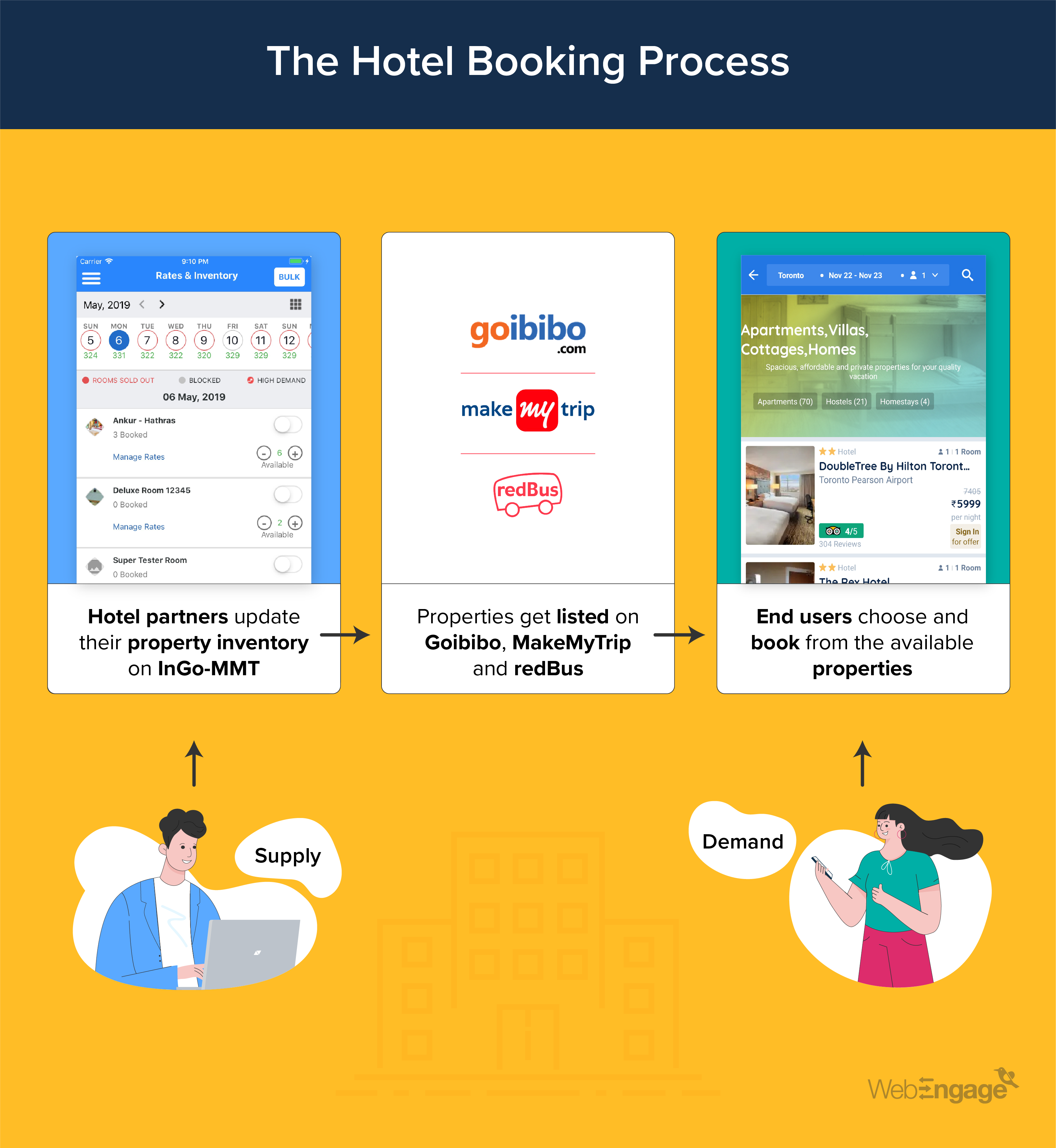

Vikalp Sahni
Co-Founder and CTO, GoibiboWe create a network effect by giving platforms to hoteliers and bus operators who can come and distribute their products into these millions of Indians, and we create experiences that are not only booking but also inspirational.
Hotel partners being core to the ecosystem, the team at InGo-MMT aimed at providing them a seamless experience through relevant engagement with the platform. And as a result, delivering a best-in-class experience to the end-users. Like any other OTA brand, the north star metric for InGo-MMT is hotel bookings.
To provide a seamless and consistent experience to the hotel partners, the team at InGo-MMT was looking out for a marketing automation platform with which they could:
- Go live faster without consuming much of their technology operations and manual bandwidth.
- Report and analyze growth and engagement metrics in a single place.
- Configure different rules based on the events happening in their backend system and build compelling user journeys on top of that.
The InGo-MMT team was clear with the requirements since the beginning and realized that WebEngage could fulfill these demands. As they were using WebEngage for the demand-side platform (Goibibo), Go-MMT decided to use it for the supply-side platform (InGo-MMT) as well.

Vikalp Sahni
Co-Founder and CTO, GoibiboWe started leveraging WebEngage for our demand-side platform (Goibibo), and then we actually saw a lot of value in it and ended up using it for our hotel partner platform as well.
And that’s how the WebEngage-InGo-MMT association kicked off. Our onboarding team was proactive enough to coordinate with the team at InGo-MMT. With various approaches being discussed, both the teams mutually decided to go with a full-fledged approach of using WebEngage along with the in-house engineering of InGo-MMT.

Amit Barnwal
Team Lead - Engineering, GoibiboInGo-MMT was able to go live within 30 days with the support of WebEngage onboarding team.
After a smooth and quick onboarding process, InGo-MMT was ready to achieve its goals and implement some primary use cases while solving certain challenges that they had already been facing.
Goal #1: Provide seamless user experience to the hotel partners
The first step to providing a seamless experience to hotel partners is to understand their behavior and actions that they perform while interacting with InGo-MMT’s app or website. These actions could be anything like:
- Updating inventory
- Updating property listing content
- Replying to customer queries
- Applying promotions and offers on the listing
- Confirming a booking and so on.
Why was it important?
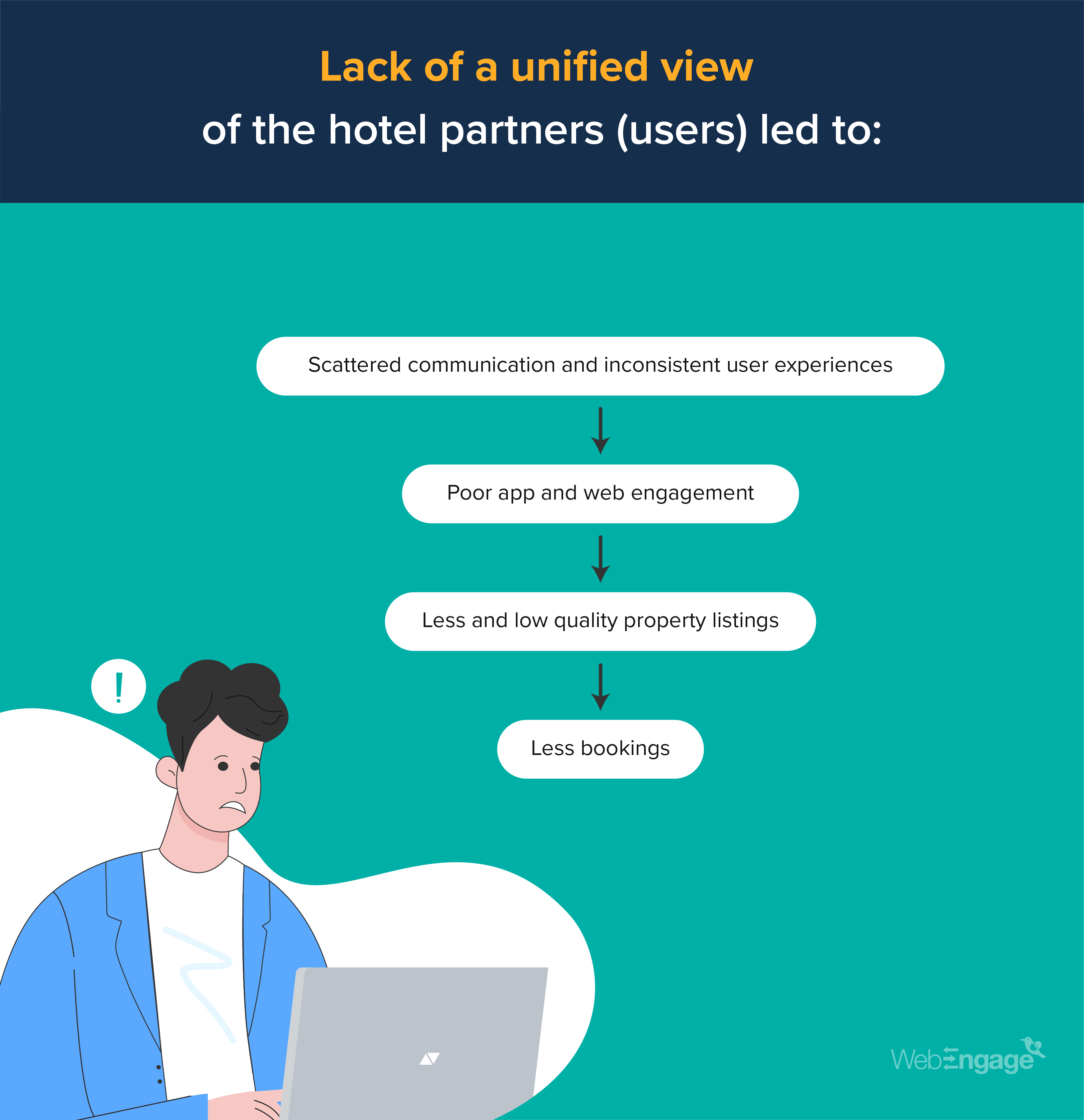
Challenge #1: Lack of a unified view of the hotel partners
When different systems were used to pull the user data to have a holistic picture, the results were rarely beneficial. InGo-MMT needed a system where they could collate all the data in one place and form a unified view of each hotel partner. To overcome this, we decided to start with the integration of InGoBox with WebEngage.
What is InGoBox?
InGoBox is an in-house mailbox exclusively developed by InGo-MMT to communicate with their hotel partners. It is available inside the InGo-MMT dashboard to provide easy and quick communication access to hotel partners.
Solution #1: Consolidation of data
Now to integrate InGoBox and other platforms that In-GoMMT was using with WebEngage, our team introduced a functionality called ‘Call an API’ on the WebEngage dashboard.
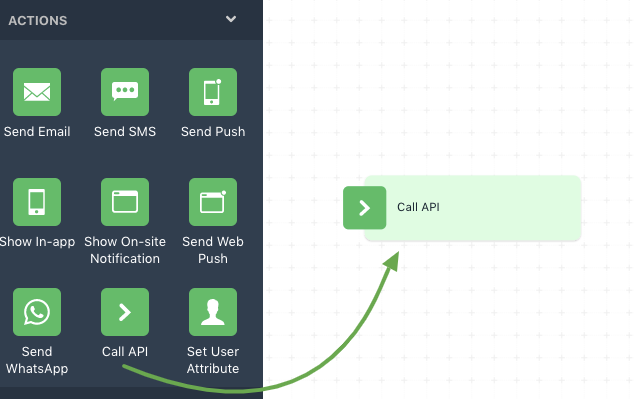
The API block establishes a connection between the backend system and the WebEngage dashboard.
It takes 3 simple steps to configure an API:
Step 1: Drag and drop the ‘Call an API’ block on the journey designer canvas.
Step 2: Click on it to build the API request. (here’s how it works)
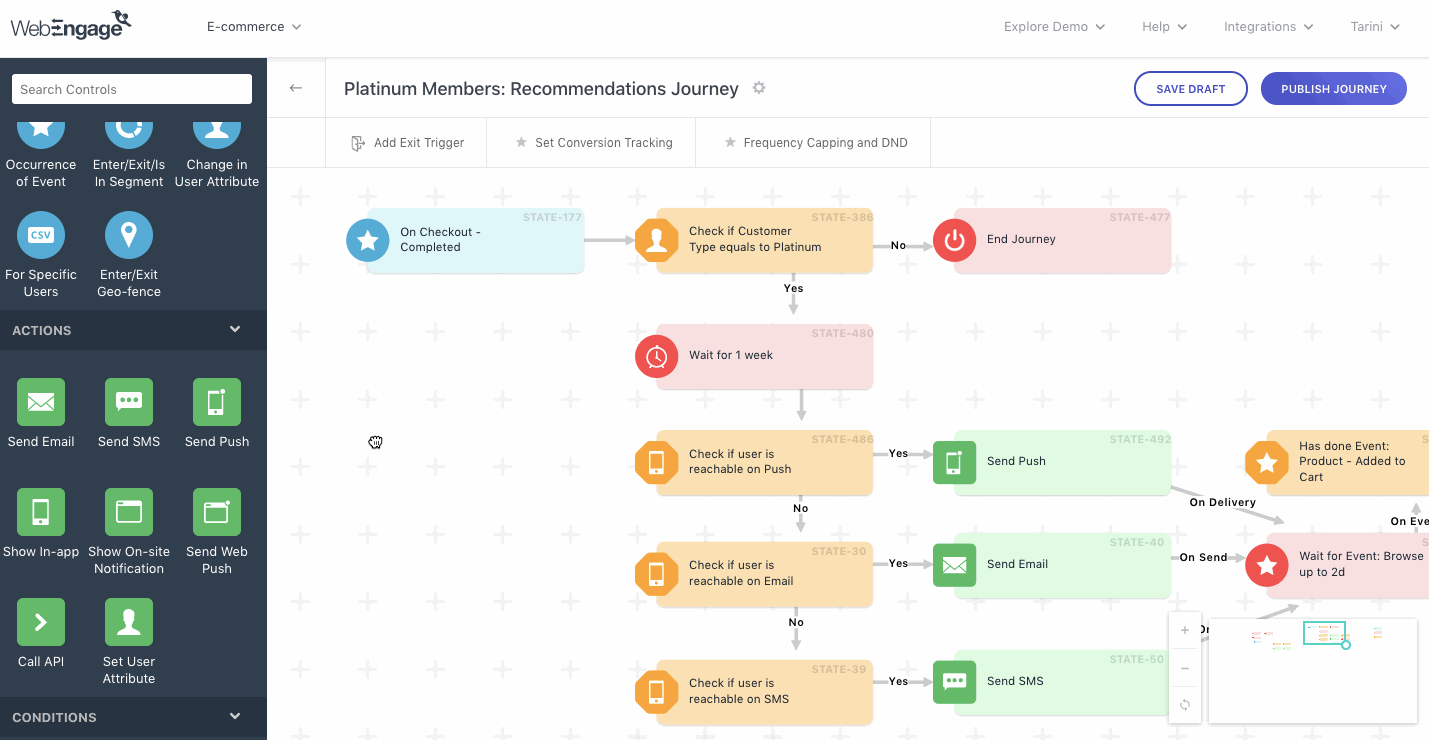
Step 3: Branch out the journey from the block to continue the trip for a hotel partner, based on the API call status. (here’s how it works)
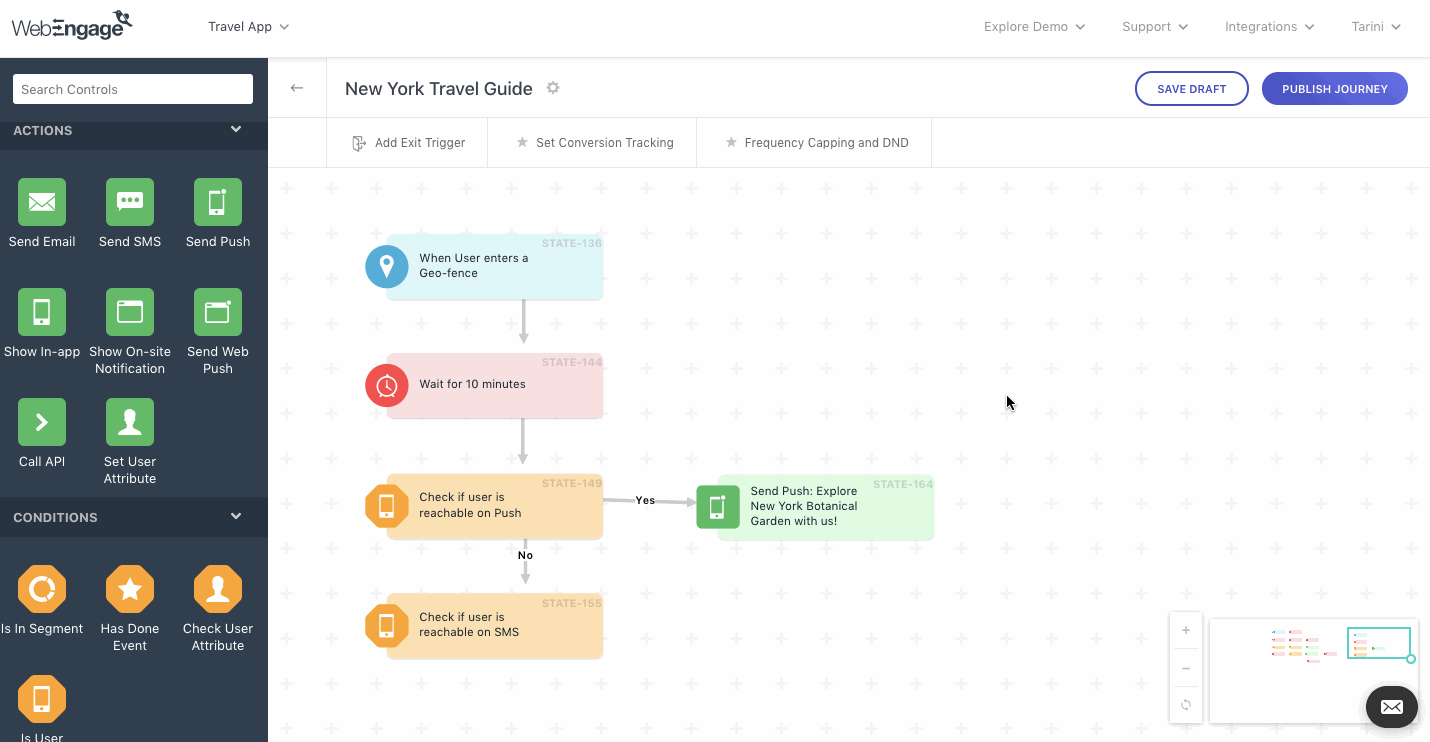
After successful integration, InGo-MMT was able to reflect all their user data and communication with the hotel partners at a single place. Hence, it enabled them to maintain a smooth and consistent communication flow, unlike earlier where the communication was just another email in the hotel partner’s inbox.
Result
InGo-MMT achieved the goal and was able to:
- Form a unified view of each of their 5 lac+ hotel partners.
- Configure 125 hotel partner (user) events on the WebEngage dashboard.
Goal #2: Increase user (hotel partner) engagement on the InGo-MMT app and website
InGo-MMT wanted to assist the hotel partners to help them update the price and listing content in a way that can result in an increased number of bookings. With relevant hotel partner (user) engagement, InGo-MMT wanted to improve the listings of the hotel partners who were getting fewer bookings or no bookings. They also wanted to keep track of metrics like Daily Active Users (DAUs), Weekly Active Users (WAUs), and Monthly Active Users (MAUs) of the platform. The only way to do it was to have multiple data points and a record of actions (events) performed by the hotel partners.
Challenge #2: Contextually reaching out to the hotel partners in real-time
Now if you know about the hotel industry, most hotel partners share a common behavior of listing their properties on multiple websites. They tend to follow this quick formula: increased number of websites = increased visibility + increased bookings. This is convincing enough for new potential income by advertising to different available demographics and markets.
Go-MMT being an experienced player in the industry, was familiar with this behavior of hotel partners and wanted to start targeting the hotel partners with the most relevant use case that is ‘Inventory’. They wanted to nudge and encourage the hotel partners to leverage the platform demand and add more inventory just in time for increased bookings.
Solution #2: Behaviour and action-based cross-channel communication
Behavioral data of hotel partners consists of the events and actions performed or not performed by the partners. For example, if a hotel partner has not performed the action (event) of ‘added a property’ during a given time frame, InGo-MMT can nudge that partner through reachable communication channels to add more inventory and get more bookings. InGo-MMT approached the user data (events and attributes) very differently than any other consumer-facing business. They did the SDK integration of their mobile app, and they also sent events through APIs from the backend system to WebEngage.
With a thoughtful approach and powerful combination, InGo-MMT was able to engage with the hotel partners through multiple communication channels like:
- SMS
- Web Push and
- Mobile Push
Coupled with WebEngage’s journey designer, each cross-channel journey can be designed using an If-this-happens-then-do-that logic.
InGo-MMT personalizes each hotel partner’s experience based on their inventory and communicates across channels by building these cross-channel journeys.
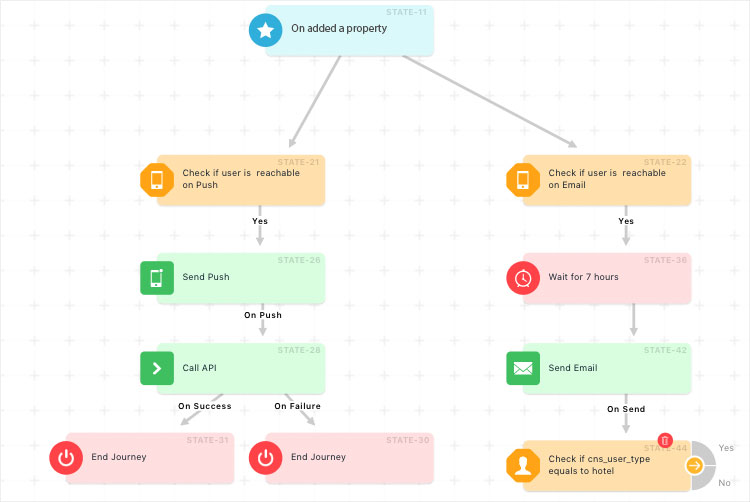
Email Campaign
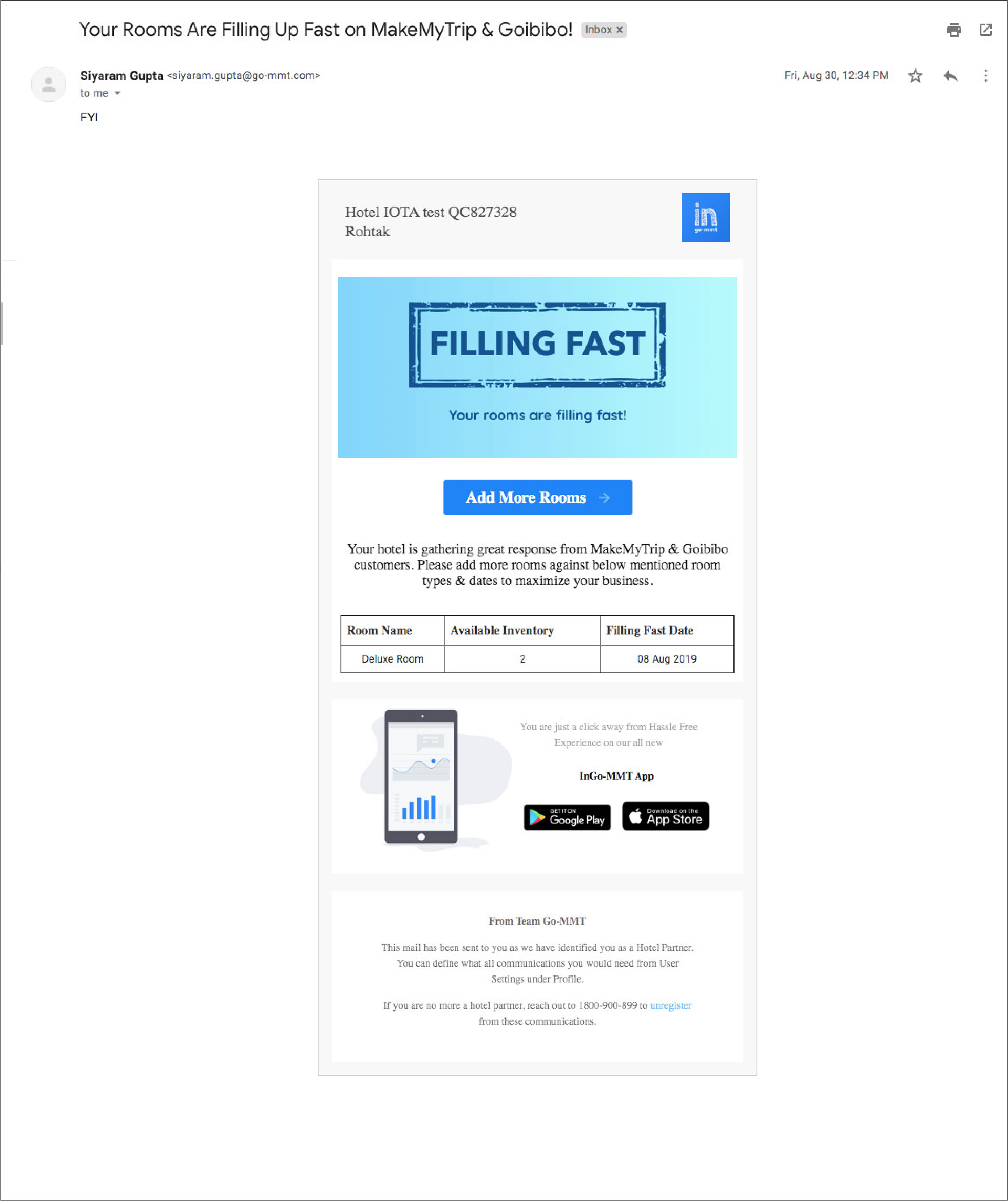
Mobile Push Campaign
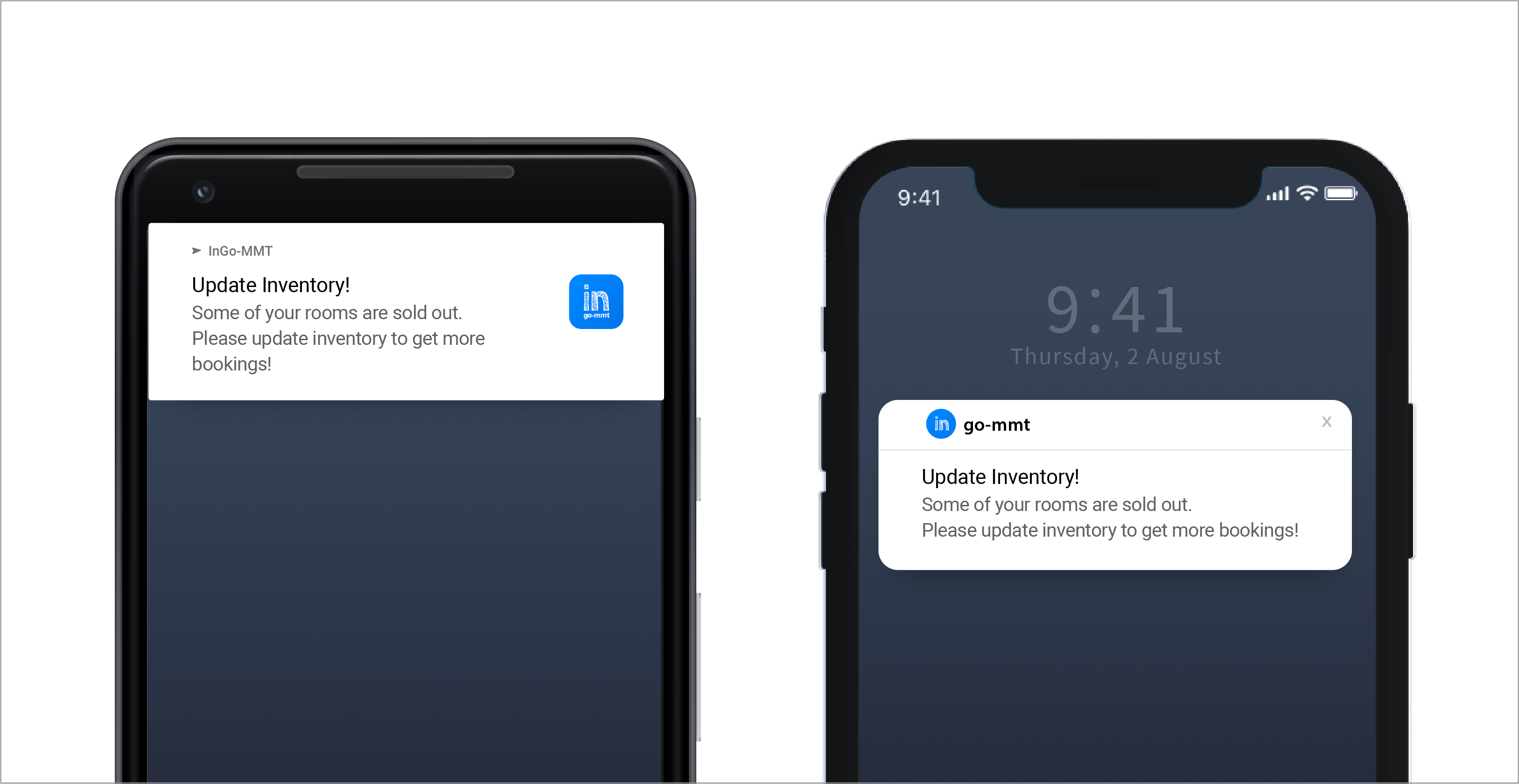
👉Pro Tip: Customize your push notifications differently for Android and iOS.
Such flexibility and personalized campaigns at scale enabled InGo-MMT to nudge and persuade the hotel partners to add more inventory and increase the number of bookings.
Result
The cross-channel journey helped InGo-MMT witness a 1.3X increase in Monthly Active Users (MAUs).
Goal #3: Retain the hotel partners (users)
Go-MMT being the largest OTA in the country works with a diverse set of hotel partners ranging from organized and branded hotels to homestays and alternative accommodations. For example, there can be a hotel partner located in India who owns a branded and organized hotel and is doing great business with InGo-MMT. Simultaneously, there can be another hotel partner located in a different geography and time zone who owns alternative accommodation and is in the process of building his/her business with InGo-MMT. The communication needs for these partners are totally different. To fulfill these needs, InGo-MMT had to send out different communication to different hotel partners at the right time.
Challenge #3: Building various segments and figuring out the right communication
Manually identifying and targeting various types of hotel partners was challenging and time-consuming.
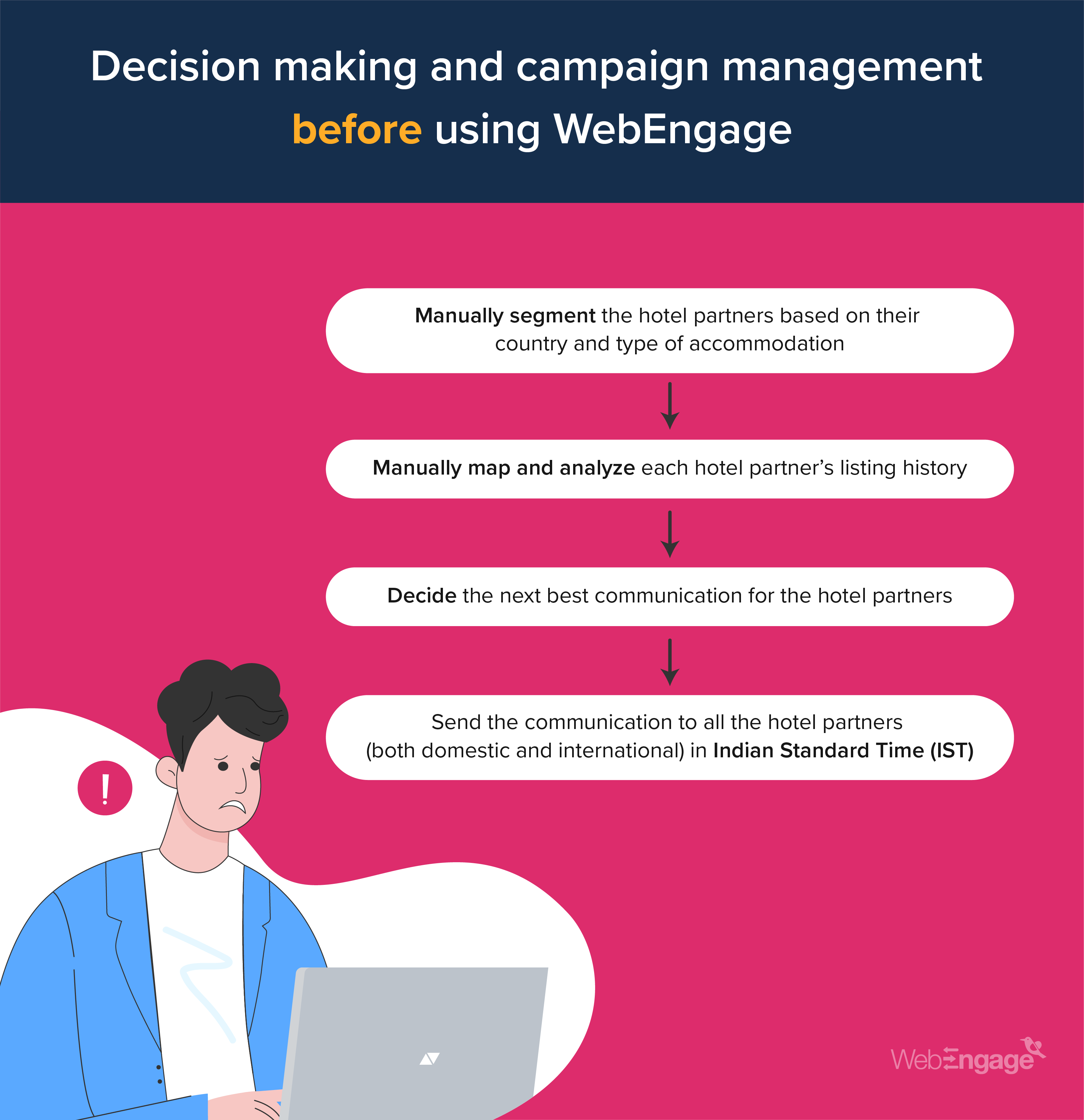
This process would require massive time and effort from a marketer.
Solution #3: Dynamic Segmentation
To deliver contextual experiences to these different types of hotel partners, the customer success manager at WebEngage assisted the InGo-MMT team in creating customized segments based on a hotel partner’s key attributes which are:
- Country
- Type of accommodation
The segments are dynamic in the sense that WebEngage tracks user (hotel partner) actions in real-time. Users (hotel partners) get added or removed from the segments as and when their actions match the rules created for a particular segment or vice-versa.

The team created different segments based on the type of accommodation, acknowledging their behavior and varied needs and thereby engaged them with contextual messaging. InGo-MMT was able to target the international hotel partners with contextual messaging in their time zone.

Siyaram Gupta
Product Manager, GoibiboWe can simply create these segments using WebEngage. In the case of our international hotel partners, while creating a journey, we can configure that the communication should be triggered to a particular user in his specific time zone.
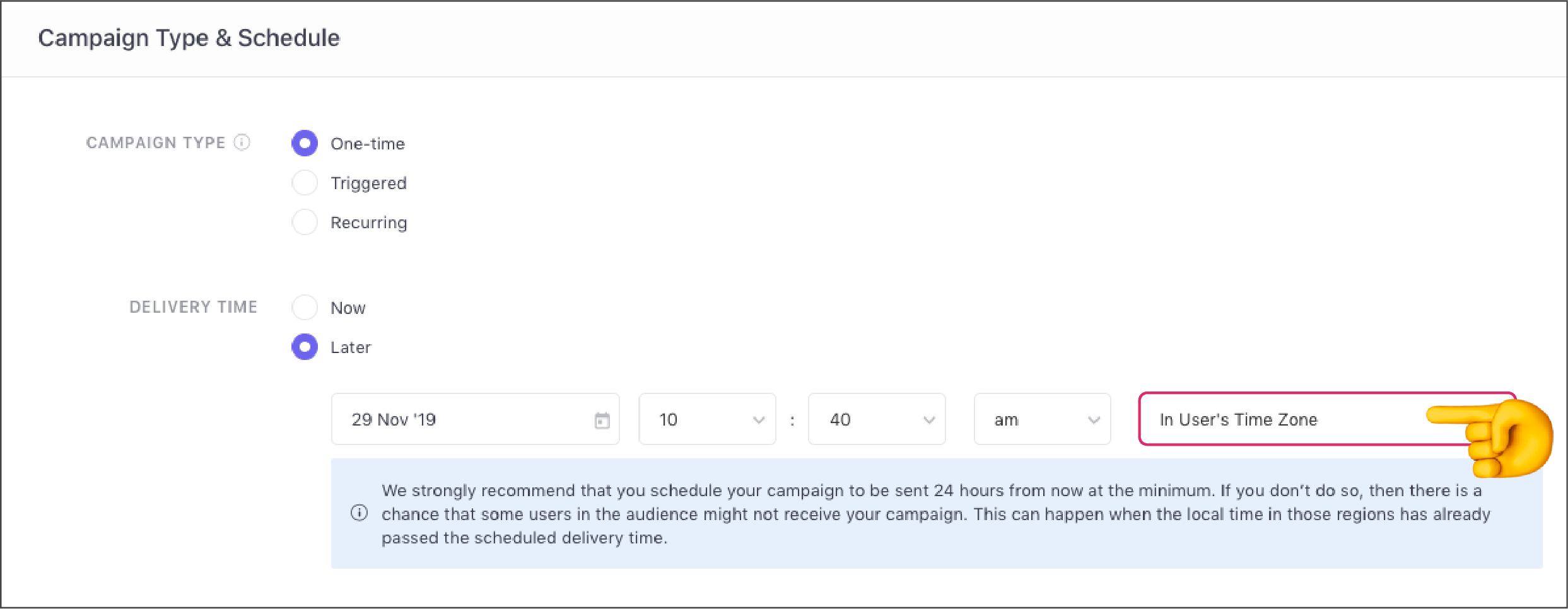
Result
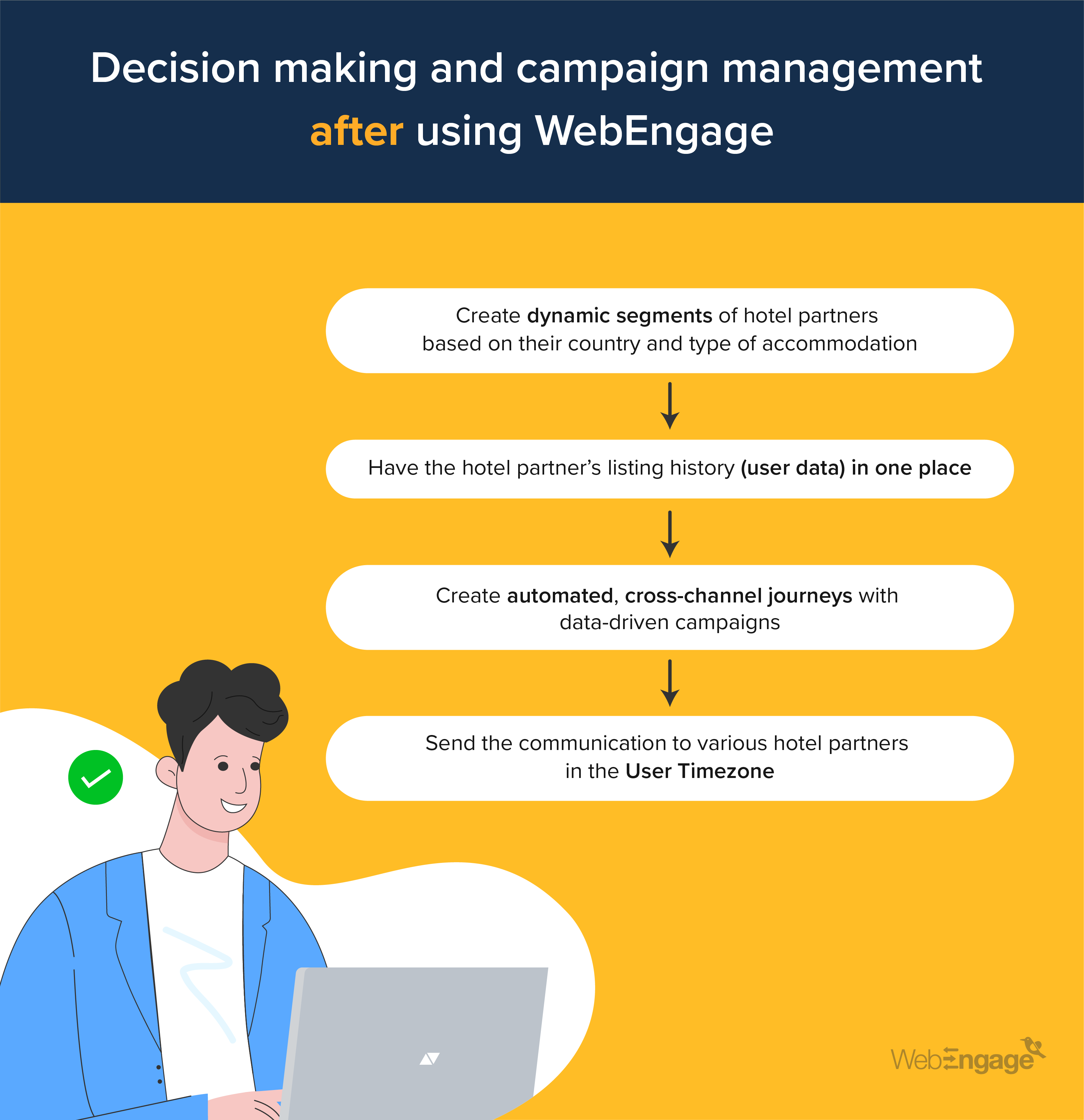
With personalized communication, InGo-MMT witnessed around a 20% increase in Monthly Active Users (MAUs) for some of the international geographies.
The WebEngage Effect
With WebEngage, InGo-MMT got a complete understanding of how the lifecycle of its hotel partners looks like. Go-MMT could easily boost their hotel partner engagement through cross-channel communication – which increased the property listings leading to increased hotel bookings by the end-users. InGo-MMT was able to:
- Go live within 30 days
- Configure various in-house platforms seamlessly
- Execute personalized, cross-channel campaigns at scale
- Improve app and web engagement
- Increase MAUs by 1.3X
- Create seamless experiences for the hotel partners
- Boost MAUs by 20% for some of the international geographies
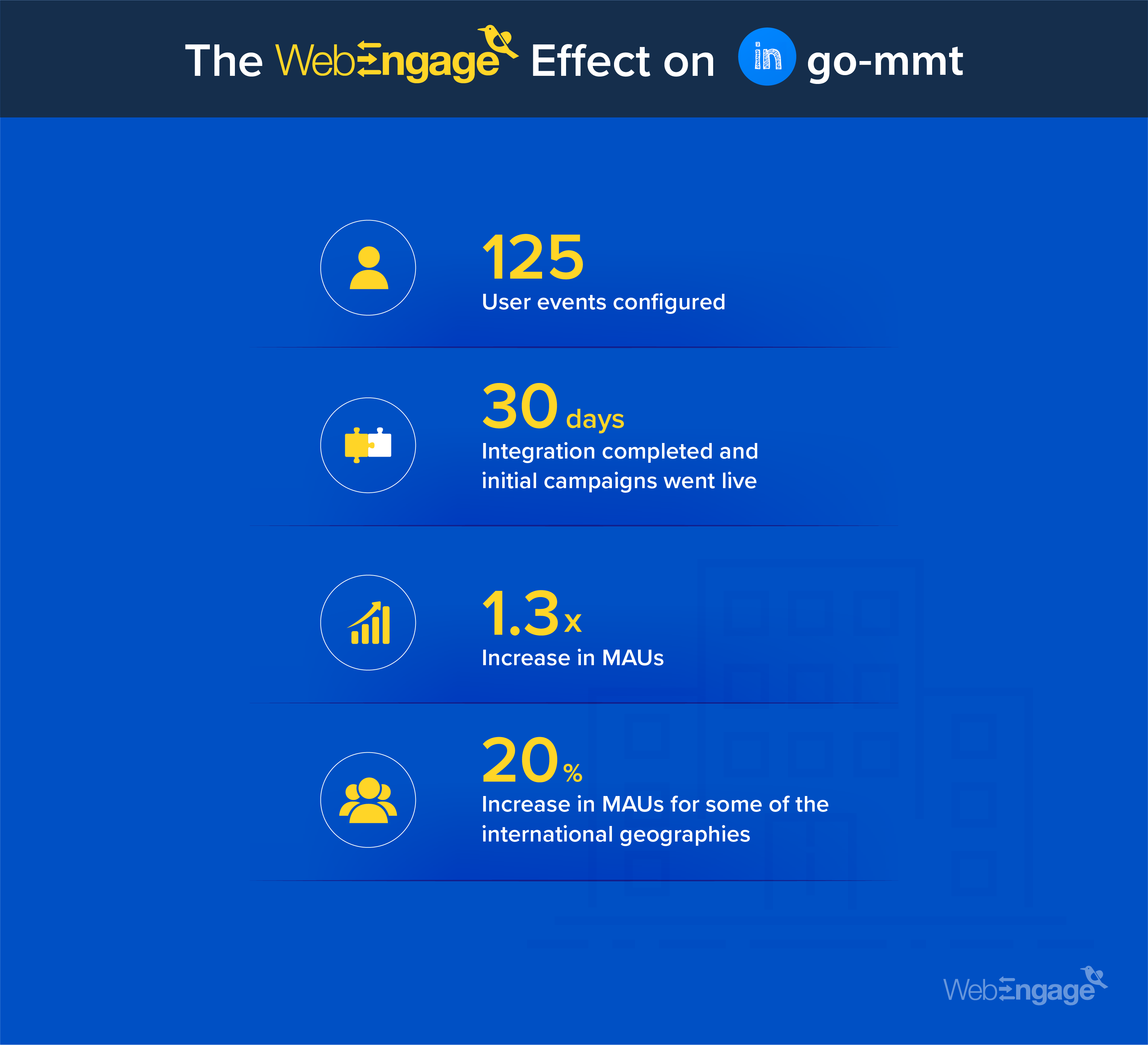
Summary
To stay ahead of the competition, providing exceptional user experiences to the hotel partners is of great importance to OTAs. WebEngage empowered Go-MMT to get a complete understanding of the hotel partners. As a result, the team was able to engage the hotel partners across channels and deliver a seamless experience.
Additionally, we are also working towards making WebEngage’s full-stack marketing automation platform highly useful for our clients. We recently added WhatsApp to our existing channels of user engagement viz. Email, SMS, Web Push, Mobile Push, In-app, and Web Overlays.
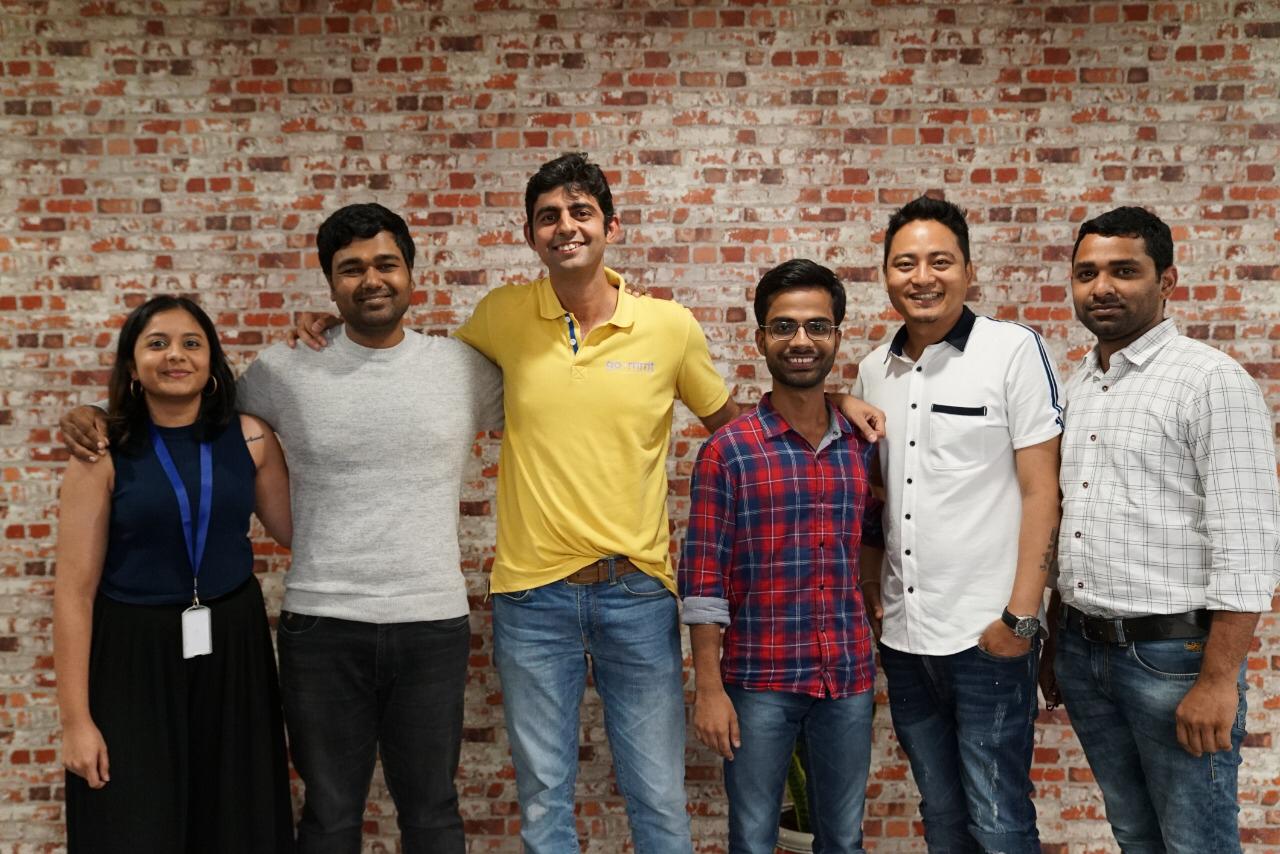
Get Started With Multi-Channel Engagement For Your Brand – Schedule A Demo










